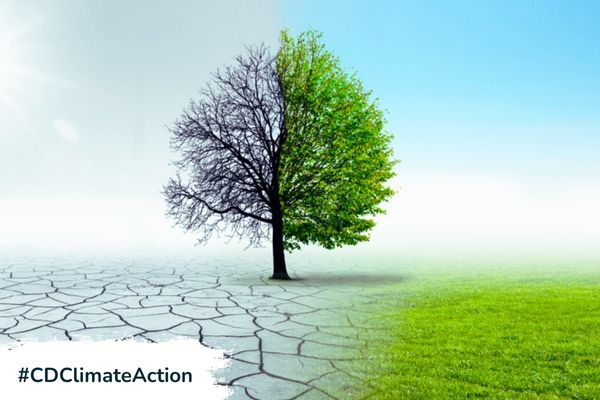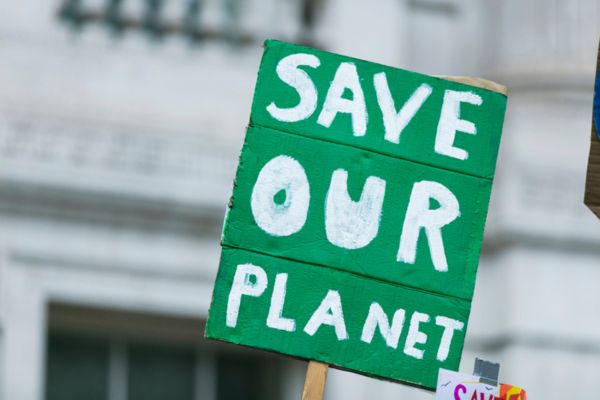Insights
INSIGHTS
All Topics
The evolution of digital technology in Earth Day campaigning
18 Apr 2024by Josie Sparling
We explore the evolution of activism and digital technology on Earth Day, from 1970 to 2023, including methods of organising, educating, and demonstrating
CHECK OUT THE ’CLIMATE ACTION’ HUB!
The first Earth Day took place on 22 April 1970, a day when people from across the U.S. came together to demonstrate against the impacts of industrial development upon human health.
In the U.S., 20 million people – including “Republicans and Democrats, rich and poor, urban dwellers and farmers, business and labour leaders” – took part in the day.
The demonstration started with three men: junior senator Gaylord Nelson; Pete McLoskey, a conservation-minded Republican Congressman; and Denis Hayes, a young activist. And it soon grew to a national staff of 85 people, and then continued to grow to include a range of organisations from faith groups, universities, and schools, to others with shared values.
These included groups that had already been working on environmental issues such as oil spills, polluting factories and power plants, raw sewage, toxic dumps, pesticides, freeways, the loss of wilderness, and the extinction of wildlife.
Analogue communications
In a time before computers and the internet became widely available, the organisers had to get the word out through analogue means to engage all of these different people and organisations.
In September 1969, Nelson made a ground-breaking speech announcing the concept of a teach-in, which received coverage in Times and Newsweek and appeared on the front page of The New York Times.
Then, in February 1970, the Earth Day team took out a full-page advertisement in ‘The New York Times’ announcing the date of Earth Day and including a tear-away section for readers to send donations to help the cause through the non-profit they had established.
Emphasising the grassroots intentions for the demonstration, the ad reads “In each community people are deciding for themselves the issues upon which to focus, and the activities which are most appropriate.”
“We can help, but the initiative must come from each community.”
In Nelson’s words, the first Earth Day worked because “it organised itself. The idea was out there, and everybody grabbed it. I wanted a demonstration by so many people that politicians would say, ‘Holy cow, people care about this.’ That’s just what Earth Day did”.
The demonstration was indeed an overwhelming success, leading to a number of foundational pieces of legislation to defend the environment in the U.S. They have “protected millions of men, women, and children from disease and death and have protected hundreds of species from extinction”.
What happened next?
Earth Day continued to take place annually, with environmental priorities shifting over time.
For example, the 1990 event boosted recycling efforts worldwide and set the foundations for the 1992 U.N. Earth Summit in Rio de Janeiro, while the 2000 event focused on global warming and clean energy. The year 2000 also stands out for the use of the internet to organise activists around the world.
In 2010, the non-profit EARTHDAY.ORG was established, and began bringing people into the environmental movement, creating opportunities for civic engagement and volunteerism in 193 countries.
In 2020, Earth Day Network, the global organiser of Earth Day, reacted to COVID-19 by announcing the entirely online Digital Earth Day, encouraging participants to use the hashtags #EarthDay2020 and #EARTHRISE to take part in the conversation.
The organisation hosted a global 12-hour livestreaming music and speaker event joined by a number of high-profile guests. This had 20 million views around the world.
The organisation also harnessed gaming livestreams happening on the day to engage new audiences with the cause, and a digital march at the White House was organized using state of the art technology, with more than two million people using avatars to join in.
Earth day today
Fifty-three years after its first occurrence, Earth Day continues to be marked by activists defending the Earth and its many people, animals, and other organisms.
Some feel that the social and cultural circumstances of today are repeating those which created the first Earth Day in 1970, and the added tool of digital and social media is recognised for its ability to unite global populations towards the same worthy cause.
The theme of 2023 Earth Day is “Invest in Our Planet”, which involves pushing away from the fossil fuel economy and old technologies and creating a “21st century economy that restores the health of our planet, protects our species, and provides opportunities for all”.
Participants can register their own events or attend existing events. The Earth Day Action Toolkit gives guidance of how to plan a march or rally and how to host a community clean-up.
It also offers Earth Day ideas for non-profit organisations, including planning community events, advocating through petitions or letter-writing campaigns, and using media platforms to spread the word, using #EarthDay and #InvestInOurPlanet.
Their website has guidance for using digital to engage in Earth Day, including planning a digital event and hosting an online community discussion.
The Social Media Toolkit for Earth Day 2023 houses all the official links, hashtags, graphics, and some social media copy to share.
The future of Earth Day
In 2022, the Wall Street Journal interviewed Denis Hayes, the activist involved in launching Earth Day in 1970, about the evolution of the event.
“Now we’ve got forest fires, we’ve got floods, we’ve got hurricanes, we’ve got all of these tragedies breaking out around the world.”
For those wanting to help with these issues on Earth Day, he explains: “A fair amount of it is trying to work on policy issues. Get your local city council to toughen the energy codes for new buildings. Get your apartment complex to put in charging stations for electric vehicles. Find something where you’re getting leverage beyond yourself.”
Taking this on board, we explore some of the possibilities of Earth Day in upcoming years.
Getting everyone involved
The future of Earth Day could involve recapturing the wide-ranging mobilisation of the 1970 event, engaging people across the spectrum of identities and political leanings.
The charity Climate Outreach has conducted several useful pieces of research surrounding how organisations can communicate about climate change to empower people in the face of the crisis. These include the research around The Climate Coalition’s ‘Show the Love’ Campaign, and their Britain Talks Climate Toolkit.
These pieces of research repeatedly show that today in Britain, all types of people are receptive to productive conversations about climate change and defending the environment.
As Earth Day continues to be a decentralised event where anyone can organise in a way appropriate to them, this means that people coming from any perspective can mobilise to defend the environment.
Youth activism
The 1970 event was inspired by the student anti-war movement and had a strong youth presence. The 2023 environmental movement is similar, with young people leading the way on defending our environment.
Jamie Margolin, a climate activist who co-founded the youth-led movement Zero Hour, says: “Pressure has been building and mounting for so many years…We need to just finally push over the edge and get this mass momentum, like what happened with the first Earth Day, when there were all these bills passed and sweeping legislation and sweeping mobilisations”.
EARTHDAY.ORG has produced an on-demand webinar with youth activists exploring the issue of plastic pollution, their experience creating change, and advice on getting involved.
To find out more about the environmental youth movement today, you can also see the organisation’s page of information about their My Future My Voice Ambassadors. These are a group of over 205 young environmental leaders from around the world who are working for the good of the environment.
We have also previously deep dived into all the ways that charities can engage with younger generations.
Artificial intelligence
In 2023, many people are excited about the possibilities of artificial intelligence (AI) and how it could impact the future. So how will the technology affect the future of Earth Day?
The answer depends on how seriously we, as a society, take the ethical concerns around the technology. Using AI to generate written text for charity campaign materials could save time, for example, but it could also come at a high cost – including inaccuracy, bias and prejudice, and the technology’s own carbon footprint.
Furthermore, the quality of writing will likely not be fit for purpose, taking into consideration nuances of ‘who, what, when, where, and why’ in the process of writing, and being able to express the need for change from an experienced human perspective.
The non-profit sector in particular should value its ability to get people involved in fresh ways that are sensitive to what is going on at any moment in time. Keeping that human heart at the centre of driving change will be vital to success.
Using digital maps creatively
Google Earth’s 3D timelapse feature, introduced in 2021, allows users to zoom into any location on Earth and track its visual changes each year from 1984. This was designed “to show how human impact is changing our forests and waterways, how cities are growing around the world, and just how beautiful the delicate ecosystem of our world is”.
The environmental movement is also already employing its own digital mapping tools to hand control back to communities – something which could increase in the coming years.
This includes Mapeo, a tool for marginalised communities to gather, share, and manage information about human rights infractions in their surrounding environment. The UK charity Carbon Copy has also produced an online map for transparency over local sustainability plans and carbon emissions broken down by sector.
Digital mapping technologies produced by non-profits can be flexible to local needs and is a tangible, productive way to address environmental issues. The use of these mapping technologies could therefore increase in the coming years. They could also be used as a supplement to the ‘teach-in’ approaches introduced on Earth Day 1970.
Virtual and augmented reality
Organisations may also increasingly use virtual and augmented reality to help communicate their work and their vision in their environmental campaigns on Earth Day.
Augmented reality has been used on Earth Day by companies such as National Geographic and Eyekandy. While the National Geographic tool was a cautionary look at climate change, presenting what different locations might feel like in 50 years, the Eyekandy tool was designed to educate and interest children in Earth Day and the planet.
In a charity context, virtual reality has been associated with an increase in empathy and influencing people towards pro-environmental behaviour. Non-profit organisations are also increasingly using the technology to market their cause.
The Ocean Conservation Trust has used virtual reality as an educational tool in schools, communities, and even parliament. The charity states, “Virtual reality…can help provide an alternative method to paper-based learning, allowing for differentiation between learners and establishing a physical connection to sometimes difficult or unusual concepts”.
Their Virtual Reality Ocean allows people to experience being in a submarine around 850 meters underwater, viewing a range of deep-sea animals. This supports the charity’s conservation work by communicating the importance of the sea in an accessible way.
These tools may be used to get people invested in Earth Day as a campaigning event and to tackle climate change year-round.
Sign up for our newsletter
Click above to receive the latest sustainability content straight to your inbox
Josie Sparling
More on this topic
Recommended Products
03 Jan 2025by Ioan Marc Jones
Ten of the best charity and non-profit websites
03 Jan 2025by Joe Lepper
Top digital tools to help charities measure their impact
03 Jan 2025by Ioan Marc Jones
An A-Z glossary of climate change terms and definitions
Our Events
Charity Digital Academy
Our courses aim, in just three hours, to enhance soft skills and hard skills, boost your knowledge of finance and artificial intelligence, and supercharge your digital capabilities. Check out some of the incredible options by clicking here.



















